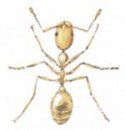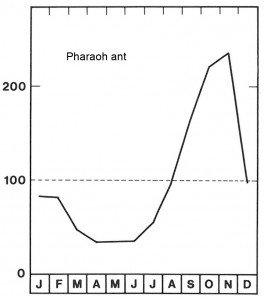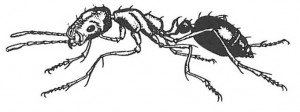Latin: Monomorium pharaonis.


A tiny, bright yellow ant. The workers are only approximately 2 mm long. It is originally a tropical species, which has spread across the world through imports. In Northern Europe it has been known since the 1920s.
In Northern Europe, the pharaoh ant depends on heated buildings. The pharaoh ant is most often found in food stocks and businesses, but can also be troublesome in canteens, hotels, hospitals and in private households. All kinds of food may be eaten by this ant. Like the common black ant, the pharaoh ant also has appetite for jam, sugar and honey. Meat products, cheese, high-fat foods, dead insects, carrion and mouse droppings are also among the things that this ant eats. In hospitals, pharaoh ants crawl into sterile products and under the patients’ bandages. Furthermore they seek out waste, carrion and drains, so there is no doubt that the pharaoh ant can carry bacteria to food.
There are usually several queens in a pharaoh ant colony. The colonies are placed in dark cavities near heat sources. Temperatures between 27 and 30 ° C are preferred. There may be several colonies in one building. The colonies live in peaceful coexistence and have some degree of connection with each other.

It’s not easy to exterminate pharaoh ants. Start by examining their prevalence so that the extermination can be done throughout the whole infested area. For this purpose, one can lay out pieces of raw pig liver in plastic bags with holes in them or on tin foil. If there are pharaoh ants nearby, they will quickly be attracted to the bait. Knowing their prevalence you can begin the extermination in the outer edges of that area and systematically work your way towards the centre. The extermination itself is to take an insecticide (liquid and / or powder) and thoroughly treat the areas where the pharaoh ants live or move, and into all suspected cracks and crevices. Application of a pesticide in restricted belts in places where the ants have to pass, for example, pipe penetrations, lists, etc. is an addition to the extermination. To exterminate pharaoh ants, a youth hormone-like substance, methoprene, has also been used with success. The method is that the hormone – embedded in a mixture of the ants’ favourite foods – is laid as bait for the foraging worker ants. They bring the mixture into the colony as food for the larvae and queens. The mixture prevents larvae from developing into adult ants and queens lose the ability to lay eggs. The hormone has no effect on the adult worker ants and finished pupae of the colony. Therefore it will take a few months before all the ants have died naturally. These substances only work on insects and are therefore completely safe for humans and pets. One can then add traditional means after a period of a few weeks after the last use of hormone-bait.




